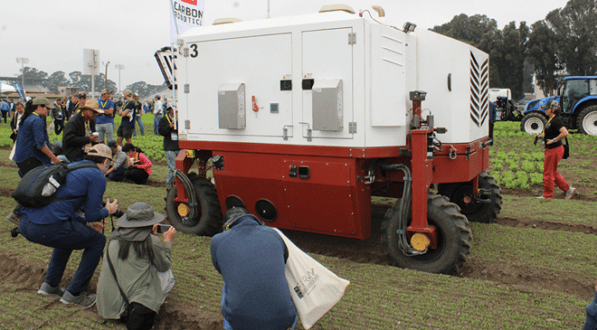

Dec 2, 2023FIRA USA AgTech innovations focus on mainstreaming automation
Despite a limited number of robots and automated machines being deployed in some grower fields, more buy-in is needed by venture capital (VC) firms that fund AgTech products.
The challenge of making robotics and smart machinery more mainstream was a key part of discussions at the Sept. 19-21 FIRA USA meeting in Salinas, California.
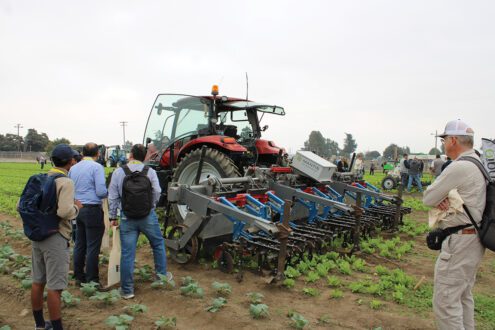

AgTech representatives and their potential customers from throughout the world trekked to the Salad Bowl of the World to view the latest in agricultural inventions and discuss incentives and barriers to adoption.
“This event is different from what would be in San Francisco,” said Gabriel Youtsey, chief innovation officer for the University of California’s Division of Agriculture and Natural Resources. “We wanted to do this event where the growers are, where farmers farm and food actually grows.”
Inside the Salinas Sports Complex, growers and tech purveyors discussed AgTech. Outside, companies parked machinery in front of exhibitor tents while demonstrations in vegetable fields and a mock fruit grove and vineyard showed growers equipment working in real time.
“It’s great to see the continuing development of robots from the year before,” said Steven Saunders, CEO and founder of Robotics Plus, a New Zealand based robotics, AI and autonomous machines designer and provider. “It’s great to see the community here and hear the good session talks.”


From tech designers and manufacturers to growers large and small, the show brought everyone in the AgTech sphere to one place.
“The soul of the FIRA event is to gather all the ag robotics industry key players to work together and get a significant impact for the development of the sector,” said Gwendoline Legrand, co-director for FIRA and GOFAR. FIRA is the France-based International Forum of Agricultural Robotics while the nonprofit GOFAR promotes and develops agricultural robotics globally.
Startups struggle with grower adoption
While panel discussions centered on how robotics and automation could solve a range of challenges growers face, including labor shortages and meeting sustainability goals through precision farming and other tech, participants acknowledged startup AgTech companies struggle with grower adoption.
“You’ve got difficult problems to solve, and you’ve got less acreage than maybe row crops or even some other specialty crops,” said Matthew Hoffman, plant health technology lead, Australia, for Driscoll’s. “I find in my role running a pest and disease management technology program that while there are many companies out there that can hang their hat on pest and disease management innovation, there are a heck of a lot fewer that are relevant to our crops.”
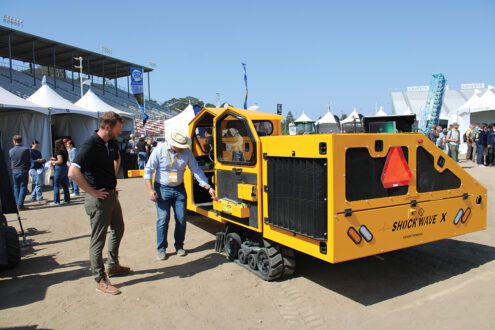

The question, Hoffman said, is if tech companies have the answers to solve growers problems, why aren’t they?
An issue the industry is seeing is that many startups are investing in harvesters, which are highly important for growers, said Mojtaba Ahmadi, senior production automation engineer for the Cal Poly Strawberry Center and the California Strawberry Commission.
“But, at the same time, we’re noticing that every single one of them is struggling to make a machine that would really benefit growers, so they won’t get adopted by growers,” he said. “And they’re always wondering why this is an issue. All those growers have a problem with labor and they really want these machines, but at the same time, they’re not adopting.”
Labor is a key driver
Rob Trice, founding partner of Better Food Ventures & The Mixing Bowl, which encourages IT and inventors to apply their technologies to food and ag, said growers want solutions to their labor problems.
“We have a lot of folks and you all can probably conjure names in your head, companies that promised the world and are falling short and took a lot of money,” he said. “You could look at the classic hype curve and think about a lot of spaces in AgTech that are in that ‘trough of disillusion’ right now.”
Trice said he worries “there’s a stench” on the horizon for AgTech and investing, because of overpromising and under-delivering.
In 2022, $29.6 billion was invested in food tech companies, a sizeable drop from 2021, with ag investments falling 11.5% in 2022, said Jennifer Marston, a global AgTech editor with AgFunder, a Silicon Valley venture capital firm that monitors food and agriculture investments.
Much of the hesitancy follows headwinds companies are facing. How can companies and researchers appeal to investors to increase those numbers, Marston asked.
“This is a really tough time to be in a startup now, especially in tech,” she said. “This is definitely a time when there won’t be a lot of funding.”
Weeding tech becomes tried-and-true
Farm robotics generated $709 million in funding in 2022, in the middle of the spectrum of farm tech investment. Weeding technology is where investment in robotics and automated tech is going, Marston said. She cited Western Growers’ Specialty Crop Automation Report, which identifies weeding as the area of farm robotics that has proven itself more than any other AgTech. People are also beginning to address how the industry can leverage robotics to make the harvesting process easier, she said.
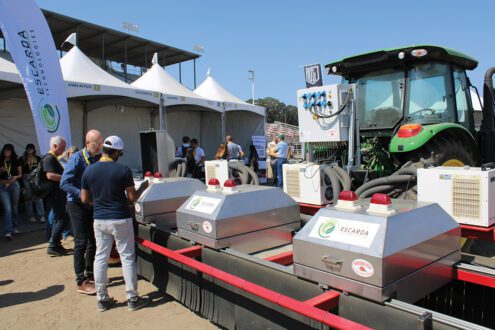

“A lot of that is investors are starting to understand where the most valuable places to invest are,” Marston said. “In what we’re dealing with, the supply chain issues, with costs and climate, we’re seeing much more capital going into these upstream companies on the farm vs. some of the more consumer-facing ones that got really big when we were all stuck at home during the pandemic.”
New technologies will be critical in helping agriculture manage its inputs, according to speakers at the event.
“There’s an opportunity for us to help the investors understand that harvest is not the only good ride to fund,” said Walt Duflock, senior vice president of innovation at Western Growers.
Duflock said investors often push back when they’re advised to consider funding other ag functions, including pest control. He referred to robot manufacturer Burro, which initially looked into designing a strawberry harvester, but decided it was too difficult. The company moved to harvest assist, which isn’t easy, either, but not as difficult as harvesting.
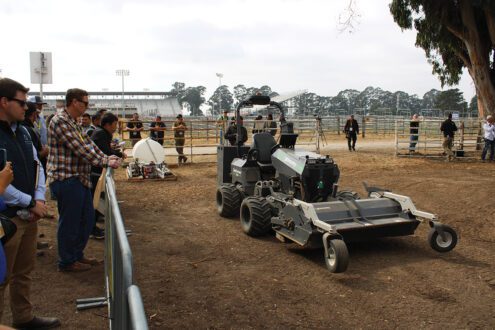

“In that case, Charlie (Burro CEO Charlie Anderson) probably got some decent pushback on size of the margin, but figured it out,” Duflock said. “So good advice to the founders. We’ll see if the future ones will take it.”
In a keynote address, Karen Ross, secretary of the California Department of Food and Agriculture, referred to the technological partnership between FIRA, University of California Cooperative Extension and Western Growers and said research infrastructure investments benefit California’s $55 billion specialty crop industry, which is dominated by smaller growing operations.
“If it’s based on inclusiveness and on technology that works for the smallest of our small farms, which is over 80% of the farmland in California, as well as our large farms, this is possible, we can create the automated solutions that can be shipped around the world,” Ross said.
More than 1,700 participants who traveled from 40 states and more than 30 countries attended FIRA USA, which featured 80 exhibitors and 56 session panelists.
— Doug Ohlemeier, assistant editor
Top photo: Field demos and sessions were a key part of FIRA USA, which brought ag robotics industry and growers together Sept. 19-21 in Salinas, California.














